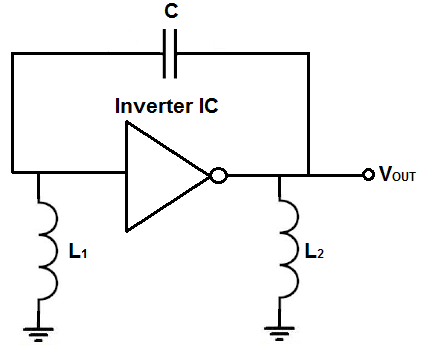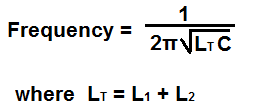Hartley Oscillator Calculator


A hartley oscillator is an oscillator circuit that uses a capacitor and 2 inductors in order to create a resonant frequency. It is a type of LC oscillator.
A hartley oscillator uses a single capacitor across 2 inductors that are in series.
Hartley oscillators can be built with transistors, op amps, or logic chips such as inverter chips. If amplification is desired, then you would need to use an active device such as an op amp or transistor.
In this circuit, we calculate a hartley oscillator frequency based on the formula, frequency= 1/2π√
This calculator uses a variety of inductor and capacitor values. This calculator tries to take into account that for breadboarding purposes, large capacitor values are usually very hard to find. Components easily obtained for capacitors are values from 1pF to 4700μF. Therefore, this calculator only uses large capacitor values (up to 1 farad) for very small frequencies such as from 1Hz to 100Hz. Other than this, large capacitor values are avoided due to the fact of not easy accessibility.
Inductor values are most commonly used in the nanohenries to microhenries range. Just like with capacitors, large values for inductors such as in the millihenry range are generally avoided due to the fact that capacitors in the millifarads range are hard to obtain and not easily accessible. In fact, in this calculator, frequency values only from 1-2Hz utilize inductors in the millihenry range. The rest of inductors are smaller, which is much more easily accessible.
In general, low frequencies require very large capacitor and inductor values. As the value of the frequency increases, the values of the capacitors and inductor get much smaller. At very high frequencies, such as in the megahertz range, very small inductor and capacitors values are used. For frequencies 1MHz to 99.99MHz, capacitors in the picofarads range and an inductor in the microhenry range are used. For frequencies 100MHz or greater, capacitors in the picofarads and an inductor in the nanohenries is used.
This calculator can handle frequencies up to a few gigahertz. After this frequency, the inductors values fall too low and inductors so small in value are hard to find, thus making the circuit uneasily accessible to build. But normally circuits don't deal with frequencies nearly so high, so this calculator can give very practical components that are easy to find.
A hartley oscillator is very similar to a colpitts oscillator. The difference is that while a hartley oscillator uses 2 inductors and 1 capacitor, a colpitts oscillator uses 2 capacitors and 1 inductor. Colpitts oscillators are probably more cost effective than hartley oscillators, because inductors are more expensive and less available generally than capacitors. So obtaining capacitors is simple, which could make colpitts oscillators a more practical, cost-effective approach.
To use this calculator, a user simply has to enter the frequency desired. The frequency can be entered in hertz (Hz), kilohertz (KHz), and megahertz (MHz). The calculator will then compute the value of the 2 inductors and the value of the capacitor.
As stated, the hartley oscillator may be built with an op amp, a transistor, or inverter logic chip, but its composition of 2 inductors and a capacitor is the same for each
case. Therefore, this formula and calculator will work for any hartley oscillator whether in a transistor, op amp, or inverter circuit.
Related Resources
Colpitts Oscillator Calculator
Op Amp Oscillator Calculator
